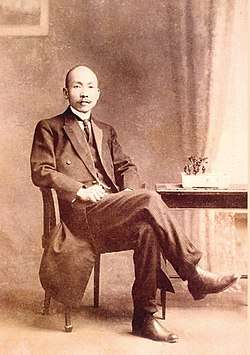Lin Hsien-tang

Lin Hsien-tang (Chinese: 林獻堂; 22 October 1881 – 8 September 1956) was a Taiwanese-born politician and activist who founded several political organizations and sat on the Japanese House of Peers.
Lin Hsien-tang's earliest Taiwan-based ancestor was Lin Shi, who traveled the Taiwan Strait in 1746.[1] Lin Hsien-tang was born in 1881 to Lin Wenqin and his wife. Lin Hsien-tang's mother died when he was young, and he was raised by his grandmother.[2] Lin was tutored at home and became a wealthy landlord based in Taichung.[2][3][4] He was born to the Wufeng Lin family, whose ancestral home is the Wufeng Lin Family Mansion and Garden, located in Wufeng District. Lin was a member of the Chestnut Leaved Oak Poetry Society, established in 1902, and offered his house as the headquarters for the group.[5][6] Lin Hsien-tang became patriarch of the Lin family in 1904, when the son of Lin Chao-tung, Lin Tzu-keng, moved to China after his father's death. Lin Tzu-keng later renounced Japanese citizenship and became the first Taiwanese to be granted Republic of China citizenship in 1913.[7] Despite living in Japanese Taiwan, Lin Hsien-tang spoke only Hokkien and did not learn Japanese.[6][8]
Lin Hsien-tang was an admirer of Liang Qichao;[3] the two met in Japan in 1907.[6] Liang stressed to Lin that China would be unable to help end Japanese colonialism in Taiwan, and advised against armed rebellion.[6] They met again in Taiwan in 1911.[6] Subsequently, Lin co-founded several sociopolitical initiatives against Japanese rule.[4][9] The Taiwan Assimilation Society, established by Lin in 1914 with the help of Itagaki Taisuke, espoused assimilation and equality between Japanese and Taiwanese.[4][9] In 1920 the Formosa Youth published its first issue.[10] The publication was funded by Lin Hsien-tang, Lin Hsiung-cheng, Koo Hsien-jung, and Yen Yun-nien.[11] Lin Hsien-tang was a cofounder of the Taiwanese Cultural Association and Taiwanese People's Party.[12][13] Lin took leadership roles in both organizations.[14][15][16] While leading the Taiwanese Cultural Association, Lin headed the Petition Movement for the Establishment of a Taiwanese Parliament to secure Taiwanese representation within the imperial Japanese government. Starting in 1921, Lin submitted annual petitions to the Imperial Diet, asking to convene a Taiwan Provincial Assembly.[6][17] The initiative, taken over by the League for the Establishment of a Formosan Parliament in 1923, was unsuccessful, and ended in 1934.[3][9] In 1926, Lin and Chen Hsin founded the Tatung Trust Company.[18] Lin and Tsai Pei-huo founded the Taiwanese Alliance for Home Rule in 1930, which advocated for local autonomy.[19] Several members of the Taiwanese's People's Party that joined the new alliance were expelled from the party, and Lin withdrew from the party in protest.[19] Lin's work with the alliance resulted in the local elections of 1935.[19][20] Lin himself was named to the House of Peers.[8] The alliance disbanded in August 1937, after the start of the Second Sino-Japanese War.[19][21] When Japanese rule ended in 1945, Lin served for a time on the Taiwan Provincial Assembly and National Assembly.[8] The provincial legislature forced land reform, despite objections from landowners, several of whom were targeted during the 228 Incident of 1947.[8][22] As a result, Lin immigrated to Japan in 1949,[8] where he died in September 1956.[22]
References
- ↑ "History Comes into Focus". Taiwan Review. 1 February 2016. Retrieved 24 June 2018.
- 1 2 Huang, Fu-San; Huang, Sam; Mulvagh, Conor (December 2012). "Lin Hsien-Tang's Taiwanese Home Rule Movement as Inspired by the Irish Model" (PDF). Taiwan in Comparative Perspective. 4: 65–68.
- 1 2 3 Hao, Zhidong (2010). Whither Taiwan and Mainland China: National Identity, the State and Intellectuals. Hong Kong University Press. p. 32. ISBN 9789622091009.
- 1 2 3 Ku, Y. (1997). Welfare Capitalism in Taiwan: State, Economy and Social Policy. Springer. p. 217. ISBN 9780230377875.
- ↑ Chu, Monique (16 June 2000). "Historic manuscripts go on display". Taipei Times. Retrieved 23 June 2018.
- 1 2 3 4 5 6 Han Cheung (25 March 2018). "Taiwan in Time: The reformer's visit". Taipei Times. Retrieved 23 June 2018.
- ↑ Han Cheung (7 May 2015). "Taiwan in Time: A question of citizenship". Taipei Times. Retrieved 23 June 2018.
- 1 2 3 4 5 Rubinstein, Murray A. (2007). Taiwan: A New History. M.E. Sharpe. p. 302. ISBN 9780765614940.
- 1 2 3 Nakano, Ryoko (2013). Beyond the Western Liberal Order: Yanaihara Tadao and Empire as Society. Palgrave Macmillan. p. 102. ISBN 9781137290502.
- ↑ Na, Su-phoh (26 July 2015). "Taiwanese youth creating new era". Taipei Times. Retrieved 23 June 2018.
- ↑ Hsu, Chien-Jung (2014). The Construction of National Identity in Taiwan's Media, 1896-2012. Brill. p. 24. ISBN 9789004227699.
- ↑ Han Cheung (2 August 2015). "Taiwan in Time: A life devoted to political freedom". Taipei Times. Retrieved 23 June 2018.
- ↑ Ko, Shu-ling (28 February 2003). "Remembering 228: Facing a violent past". Taipei Times. Retrieved 23 June 2018.
- ↑ Han Cheung (22 January 2017). "Taiwan in Time: Say no to opium". Taipei Times. Retrieved 23 June 2018.
- ↑ Lee, Shiao-feng (7 August 2004). "Chiang Wei-shui deserves to be honored". Taipei Times. Retrieved 23 June 2018.
- ↑ Yu, Sen-Lun (10 January 2003). "Discovering the people who made Taiwan". Taipei Times. Retrieved 23 June 2018.
- ↑ Han Cheung (16 October 2016). "Taiwan in Time: Anti-colonial messages from the sky". Taipei Times. Retrieved 23 June 2018.
- ↑ Yang, Ching-tsu (28 February 2000). "Disillusion forged a new identity". Taipei Times. Retrieved 23 June 2018.
- 1 2 3 4 Han Cheung (12 August 2018). "Taiwan in Time: Fractured resistance". Taipei Times. Retrieved 12 August 2018.
- ↑ "Taiwan". Encyclopedia Britannica.
- ↑ Shin, Gi-Wook; Sneider, Daniel C., eds. (2011). History Textbooks and the Wars in Asia. Routledge. p. 180. ISBN 9781136830914.
- 1 2 Huang, Junjie (2006). Taiwan in Transformation, 1895-2005. Transaction Publishers. pp. 40–41. ISBN 9780765803115.